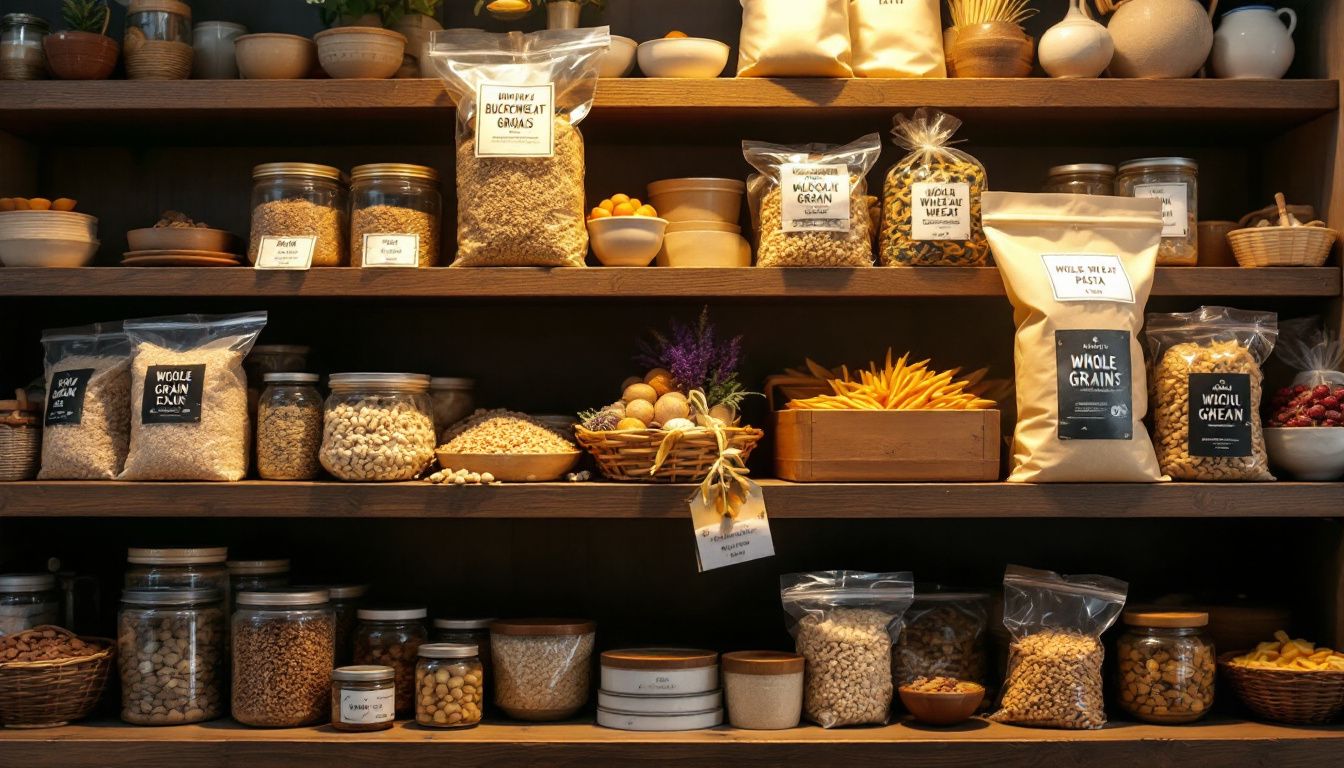Finding true whole grain foods at the store can be tricky. Many products claim to be “whole grain,” but not all of them are what they seem. This guide will show you how to spot real whole grains like brown rice, buckwheat groats, and whole wheat pasta with ease.
Thank you for reading this post, don't forget to subscribe!Ready for smarter shopping?
Key Takeaways
- Look for the Whole Grain Stamp on packages. The 100% Stamp means all grains are whole, while the 50%+ and Basic Stamps include at least 8 grams of whole grains per serving.
- Check ingredients lists for “whole” as the first word, like “whole wheat flour.” Avoid terms like “multi-grain” or just “wheat bread,” which might use refined flours.
- Whole grain foods often have a darker color and coarse texture compared to refined options. Don’t rely only on appearance; check labels too.
- Compare nutrition facts: pick products with at least 2 grams of fiber, less than 6 grams of sugar, and over 3 grams of protein per serving for better health benefits.
- Be careful with misleading packaging claims like “Honey Wheat” or dark-colored bread made with dyes instead of real whole grains. Always read labels carefully!
Look for the Whole Grain Stamp
Check food packaging for the Whole Grain Stamp. This stamp makes spotting whole grain foods easier. It comes in three types: 100% Stamp, 50%+ Stamp, and Basic Stamp. The 100% Stamp means all grain ingredients are whole grains, with at least 16 grams per serving.
The 50%+ Stamp shows half of the grains are whole and gives a minimum of 8 grams per serving since January 2017. The Basic Stamp also ensures at least 8 grams of whole grains but may include refined flour.
Over 13,000 products in more than 60 countries feature this stamp—making it widely accessible to shoppers! Three items labeled “100% Whole Grain” or six products with any Whole Grain Stamp meet daily recommendations for healthy eating.
Move on to examining ingredient lists after checking for stamps.
Read the Ingredients List
Check the ingredients list carefully. The first ingredient should say “whole,” like whole wheat or whole oat.
Check for the word “whole” at the beginning of the list
Ingredients like “whole wheat flour” or “whole oats” should be listed first. This means the product is made from whole grains, not refined ones. If you see words like “wheat flour” or just “flour,” it likely contains refined grains instead.
Refined flours lack the bran layer and key nutrients found in whole grain foods.
Be cautious of misleading terms such as “multi-grain” or “stone-ground.” These phrases don’t guarantee the food includes whole grains. Stick to spotting “whole” at the start of the ingredient list for true whole grain products.
*“Whole grains provide more fiber and nutrients than their refined counterparts.”*
Next, examine if color and texture offer clues about healthiness…
Examine the Product’s Color and Texture
Products like whole wheat bread or brown rice often look darker than refined options. Whole grain foods keep the entire kernel, giving them a natural brown color. Lighter products might use refined flour, missing key nutrients.
Texture can also give clues. Whole grains feel coarse or rough rather than smooth. For example, oat groats and buckwheat groats have a hearty feel compared to soft all-purpose flour or finely milled wheat flour.
Be Wary of Misleading Packaging Claims
Labels can be tricky. Words like “Multigrain,” “Honey Wheat,” or just “Wheat Bread” may make a product sound healthy. But often, these foods contain refined flour instead of whole wheat flour.
Always check for phrases like “100% Whole Grain” or “100% Whole Wheat.”.
Veggie wraps and similar items might seem wholesome but could rely on white flour as their base. Don’t assume darker bread equals healthier bread either—molasses or dyes might just change the color without adding health benefits.
Read the ingredients list to ensure you’re picking real whole grain foods like whole wheat or buckwheat groats.
Compare Nutritional Labels
To find truly whole-grain products, comparing nutritional labels is key. Here’s a quick breakdown to help you decode them at the grocery store:
| Nutritional Factor | What to Look For | Why It Matters |
|---|---|---|
| Fiber Content | At least 2 grams per serving | Supports digestion, reduces cholesterol, aids weight management |
| Whole Grain as First Ingredient | The word “whole” (e.g., whole wheat, whole oats) | Indicates a true whole-grain product |
| Serving Size | Realistic portion based on your diet | Helps measure daily nutrient intake correctly |
| Sugar | 6 grams or less per serving | Prevents unnecessary calorie intake |
| Protein | At least 3 grams per serving | Keeps you full longer |
Check for fiber first—it’s a good indicator of whole grains. Products lower in sugar and higher in protein tend to be healthier options too. Ready to spot misleading claims next? Let’s explore!
Conclusion
Spotting whole grains doesn’t have to be hard. Check labels, read ingredients, and ignore tricky packaging. Small changes, like picking brown rice or whole wheat bread, can make meals healthier.
Shop smart and save money by buying in bulk bins. Whole grains mean better health—and that’s always worth it!
For more healthy eating tips, check out our guide on satisfying steak and burger substitutes for meat lovers.
References
- https://foodinsight.org/whole-story-on-whole-grains/
- https://weighinginblog.org/blog/quick-guide-to-whole-grains-and-why-the-whole-grain-stamp-falls-short
- https://www.mayoclinic.org/healthy-lifestyle/nutrition-and-healthy-eating/in-depth/whole-grains/art-20047826
- https://www.simplyfresh.info/10-tips-for-purchasing-and-storing-whole-grain-foods/
- https://dining.uga.edu/finding-whole-grains/ (2021-03-30)
- https://www.cspinet.org/article/how-spot-best-whole-grain-wraps-pitas-buns-bagels-etc
- https://pmc.ncbi.nlm.nih.gov/articles/PMC7468996/
- https://wholegrainscouncil.org/whole-grain-stamp
